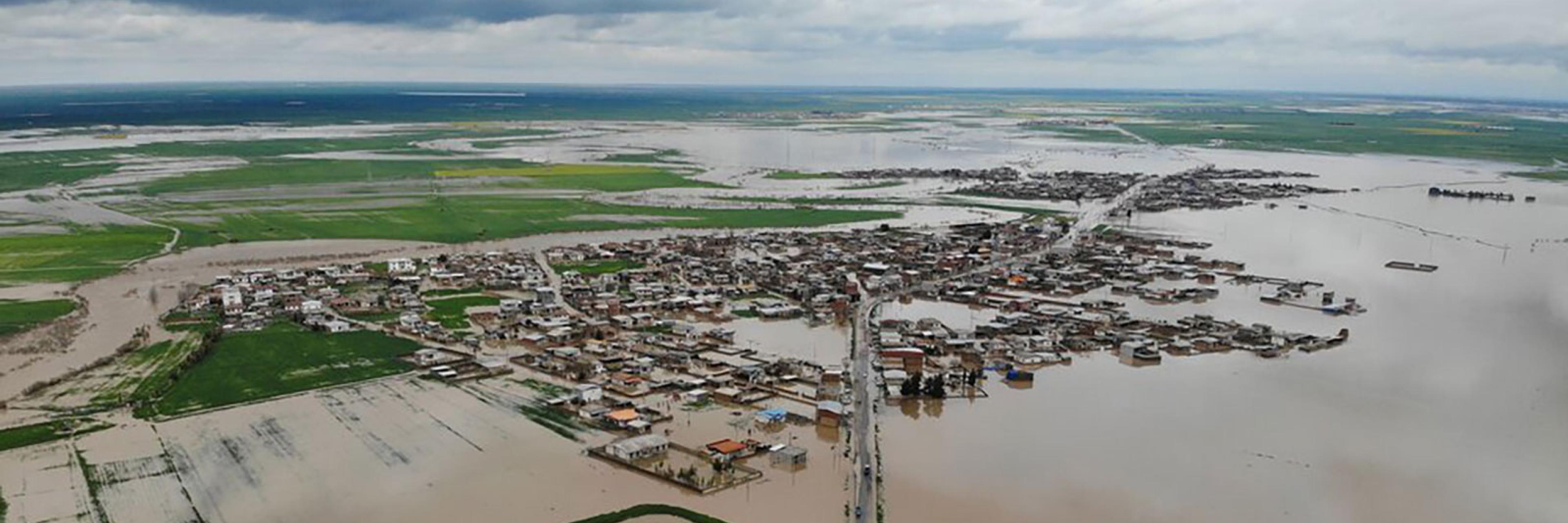
Natural Disasters Research Institute(NDRI)
There is a special competition among many metropolitans for improving physical and semantic quality of urban landscape to upgrade their positions in global level and attract more tourists. Based on such characteristics, one of the important goals of metropolitan management planners of the society is to develop open populated spaces and make leisure centers. Urban spaces development in the present era without sufficient knowledge of urban rivers characteristics and taking advantage of their potentials has had many problems for the cities. Zayandeh Rud is one of the largest rivers in Iran. It is flowing on the center of the country and from west to east. Many tourists visit Zayandeh Rud each year, because several historic bridges are remained from Safavid Majesty and before over this river and it is also located in historical city of Isfahan. But it is a few years that this large river has been exposed to drought; this issue, in addition to the effects on the rate of tourism of the city, encounters the fanners of this area with irrigation problems.
Rationale
Zayandeh Rud River as one of the largest rivers of central plateau of Iran is located in Gavkhooni area. Zayandeh Rud originates from Zard Kooh Bakhtiari, Haft Tanan in the area of Shourab Tang-e-Gazi in Chaharmahal Bakhtiari Province. After absorbing running waters in some parts of Faridan and Fereydoon Shahr it flows towards Isfahan city. The length of this river is 405 km and the average slope of the channel bed 15 percent. Eventually, this river terminates in Gavkhooni Swamp, about 120 km in southeast of Isfahan. Average annual rainfall along the river is 450 mm and the extent of catchment area is about 27,100 km2. Isfahan city's share of the river water that used to be distributed in the city through 9 major streams and their sub-branches is so high that in the recent eras it converted this city as a garden city (existence of 158 gardens and farms) and its passages as garden alleys. The main reason of Zayandeh Rud nomination to this name is that it revives and reclaims many villages, gardens, and farms. From ancient times, this river has been named as Zayandeh Rud, Zendehrud, Zand Rud, Zarin Rud, Zarinehrud, Zarnrud, and Zandak Rud. On one side, this river as artery and vital vein itself has had an important role in residents' leisure. Beside other cultural and economic profits for Isfahan city, Zayandeh Rud River has made a public area to develop humans' social interactions with each other. In addition a place for entertainment and leisure, the river provided a special position for urban identity of Isfahan citizens. This river shapes influential in the main identity of Isfahan city. This can be felt due to different signs and symbols that are visible in culture of Isfahan city and each has a sign of Zayandeh Rud.
In recent years, the Zayanderood River in Isfahan-Iran has been encountered by hydrological imbalance and drought. Literature review shows that long-term climate change, drought, and disruption of the river’s water supply has led to depletion of underground aquifers and, consequently, gradual subsidence of the river and serious damage to old buildings and structures along the riverbank. This fact would be followed up by adverse environmental, social, and economic effect that could threaten the sustainable development of urban space. Therefore, it is necessary to use efficient risk identification and assessment approaches toward a more effective risk management.
The Land subsidence (LS) cases, is discussed as a worldwide environmental, geological, and global geohazard concern. Human-induced LS cases are significantly more than groundwater extraction contributes. LS could threaten the sustainable development of urban space by adverse environmental, social, and economic effect. Therefore, it is necessary to use efficient risk identification and assessment approaches toward a more effective risk management. The drying up of the Zayandeh-rood is the most visible sign of the water crisis that threatens the existence of this city. Groundwater levels have fallen, wells have dried up and ecosystems have been destroyed. The crisis requires strong steps from the national and local governments to address the inadequate and failed policies of previous administrations. Zayandehrood can be used as a suitable case study for other parts of the world in this field.
Strategy
The consequences of the drying up of the Zayanderood river as follows:
- Municipal Water Shortage
- Extensive land subsidence and damage to people's property and historical heritage
- Widespread poverty in the agricultural sector
- Environmental destruction
- Intensification of the dust phenomenon
- Uncontrollable social tensions
- Property depreciation
- Mass migration of people to other provinces
Recent reports from Isfahan, have proclaimed cases of land subsidence arising from persistence of drought events and groundwater overexploitation. In recent years, the Zayanderood River in Isfahan-Iran has been encountered by hydrological imbalance and drought. Literature review shows that long-term climate change, drought, and disruption of the river’s water supply has led to depletion of underground aquifers and, consequently, gradual subsidence of the river and serious damage to old buildings and structures along the riverbank. Overall, land subsidence appears to increase from south towards the northern, northeastern, and eastern sectors of Isfahan Metropolitan, while the southern sectors are nearly a stable area. Close to 2.5 million residents in the region are being unsettled by the gradual or sudden sinking of the ground. There are totally 35 plains in the region that rapidly declining water resources have impelled water officials in the arid province to increase the number of plains from which water withdrawal is banned to 30. In this light, because of the importance of the matter, the main focus of the project will be on this issue and solutions to deal with it.
Methods
The various necessary steps to achieve our revitalization goals are:
- Reduce allowable costs
- Remove unauthorized uses
- Supply of new water resources
- Water Quality Management
- Reducing dependence on water resources
Climate disruption is the greatest challenge to the psychological, emotional, spiritual, and social health and welfare of humanity today. Considering the land subsidence as a main climate disruption accruing in the Isfahan, and its relationship with Zayandeh Rud revitalizing, we set some transformational resilience and “justice” goals. Because Transformational Resilience offers a groundbreaking approach to responding to climate disruption. We intend to start our work with focus on empowering all people with the capacity to remain actively involved in constructive climate change initiatives and adapt to climate impacts. In this regard, our main goal is focusing on important concept of environmental sustainability and climate resilience. In this regard we define some goals contributing to have a climate resilience and environmental sustainability:
- Designing non-structural measures that mitigate climate change impacts especially in Zayandeh Rud basin.
- Implementation of Nature-based solutions (Nbs) for disaster and climate resilience.
- Redesigning urban green spaces based on water and climate resources.





